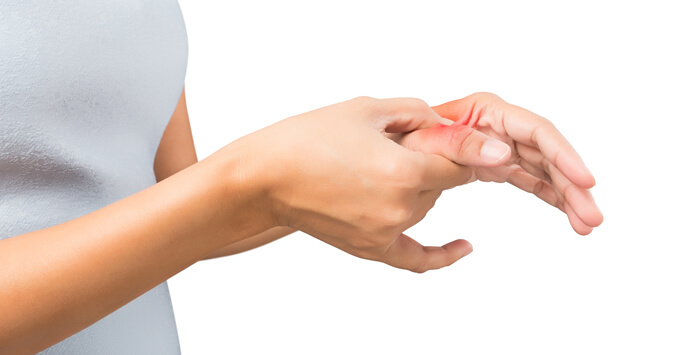Arthritis can affect nearly every joint in your body and your hands, but a very common area for arthritis is the thumb. Thumb arthritis tends to occur in your hands sooner than other forms of arthritis, but other than some minor stiffness, it may take several years before you experience any significant problems. If ignored, however, the arthritis may progress to a more serious level, perhaps even requiring surgery.
So why is a thumb so susceptible to arthritis? And is there any way to prevent it? Read on to learn more.
Arthritis Basics
Before we get into why arthritis affects thumbs more often than other parts of the hand, let’s start with the basic definition of arthritis.
In simple terms, the most common form of arthritis, called degenerative arthritis, occurs when the lubricating, cushioning cartilage at the ends of bones wears away. As a result, the bones rub against each other, causing stiffness, pain, and swelling.
The word “arthritis” is a general word used to describe joint pain or joint disease. In fact, there are more than 100 different types of arthritis, and they affect approximately 300,000 children and 50 million adults. It is more common among women, and risk factors include age, obesity, and lack of physical activity.
Why Thumb Arthritis is Common
The most common type of arthritis in the hands involves the last joint of each finger (nearest the tip), but the second most common is thumb arthritis.
It is also known as basal joint arthritis and occurs when cartilage at the base of the thumb wears away. At first, the symptoms can be so mild that you only notice the problem when you’re trying to do something like unlock a door, zip up your jacket, or snap your fingers, but the symptoms may get worse with time.
The simple reason why it is so common is because of how much we use our thumbs, as well as the fact that the thumb can move in different directions, causing more stress on the joint. The saddle-shaped joint gives the thumb the ability to move down, up, and across the palm, as well as to pinch.
In addition to age, thumb arthritis is often brought on by injury and may be hereditary.
Thumb Arthritis Prevention, Remedies, and Treatments
You might not be able to completely prevent arthritis, but you may be able to delay it or reduce its effects. Some ways to avoid the progression of thumb arthritis, hand arthritis, or arthritis in other parts of the body include:
- maintaining a healthy body weight
- making efforts to protect yourself from injuries when participating in sports, games, or other activities that strain your hands, such as bowling, knitting, cooking, gardening, or home and automobile repair and maintenance.
- eating a balanced diet rich in fruits, vegetables, whole grains, and spices that fight inflammation
- taking precautions to avoid injuries when pulling, pushing, or lifting objects
- using a wrist cushion and a special keyboard if you use your computer often
- exercising your hands, just as you would other parts of your body, to keep your fingers flexible.
In more serious, acute cases, you can get temporary relief by applying ice to the area or using a heating pad. Both methods have been known to be effective, but it depends on the type of pain and swelling you’re experiencing. Ask your doctor what’s best in your case.
Other remedies may include taking medication, having a cortisone injection at the basal joint area, or having your doctor set the thumb with a splint.
If necessary, treating thumb arthritis may require surgical procedures, such as a trapeziectomy that involves removal of a bone in the wrist, an osteotomy that realigns the bones, or joint replacement with grafts from tendons.
If you are suffering from arthritis pain in your thumb or anywhere in your hands, schedule an appointment to come see us. We’ll help you identify the right treatments for you.













